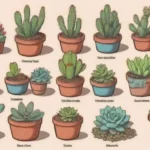
Botanical Expeditions: Discovering Succulents Across Continents

Introduction
The world of botany is a vast and captivating realm that offers endless opportunities for exploration and discovery. Among the diverse plant species that grace our planet, succulents have gained a reputation for their unique forms, astonishing adaptations, and diverse habitats. These remarkable plants, often characterized by their thickened, fleshy parts designed to store water in arid environments, have become incredibly popular, both in gardens and as houseplants. The intrigue surrounding succulents extends beyond their aesthetic appeal; they serve as a testament to the hardiness of life in harsh conditions, inspiring botanists and plant enthusiasts alike to delve deeper into their world.
This article aims to take readers on an exciting journey through various botanical expeditions focused on discovering succulents across different continents. We will explore the origins, preferred climates, and conservation efforts surrounding these fascinating plants while emphasizing their ecological importance and the challenges they face. By understanding the complex interrelation between succulents and their environments, we can better appreciate their role in our world and advocate for their preservation.
The Fascinating World of Succulents
Succulents belong to a diverse group of plants that have developed specialized adaptations allowing them to thrive in arid or semi-arid climates. A defining feature of these plants is their ability to store water within their leaves, stems, or roots, which enables them to survive long periods of drought. This adaptation not only allows them to endure unfavorable conditions but also aids in their survival amidst a history of climate change that has left many ecosystems vulnerable.
The Evolutionary Journey of Succulents
The evolutionary journey of succulents is a captivating subject that illustrates how plants adapt to their environments over time. Succulents have emerged independently in different plant families, enabling them to develop unique adaptations suited for water conservation. For instance, members of families like Crassulaceae, Cactaceae, and Euphorbiaceae have evolved to fill similar ecological niches, despite having very different ancestral backgrounds. For example, the common jade plant (Crassula ovata), known for its thick green leaves, contrasts intriguingly with the striking saguaro cactus (Carnegiea gigantea), yet both demonstrate remarkable water retention abilities.
This phenomenon, known as convergent evolution, shows how organisms can develop similar traits while originating from different ancestors due to facing comparable environmental pressures. As various succulent species evolved across distinct geographies, they adapted to an array of ecosystems— from deserts and rocky terrains to grasslands and coastal regions.
A Showcase of Succulent Diversity
Succulents are incredibly diverse, boasting thousands of species across the globe. In their native habitats, one can find succulents in astonishing varieties that differ in shape, color, and texture. The iconic aloe vera is not only celebrated for its medicinal properties but also exhibits a rosette formation of fleshy leaves that radiate outward, creating a stunning visual display. In contrast, the agave plant, often mistaken for its cactus cousins, features sturdy, spiky leaves that culminate in a dramatic point, serving as a prime example of the variety within the succulent family.
Furthermore, Lithops, commonly known as "living stones," have developed a unique morphology that allows them to blend seamlessly with gravel and rocks in their native South African habitats. This camouflaging ability not only protects them from herbivores but also emphasizes the adaptations succulents have made to succeed in difficult environments. Discovering and studying these various forms can be both an enlightening and fulfilling experience for botanists, horticulturists, and enthusiasts alike.
 The Intriguing Tales Behind Popular Succulent Species and Names
The Intriguing Tales Behind Popular Succulent Species and NamesThe Global Expedition to Discover Succulents
Botanical expeditions dedicated to discovering succulents across continents have significantly contributed to our understanding of these remarkable plants. Such expeditions are critical for gathering data related to different succulent species' taxonomy, distribution, habitat requirements, and ecological roles. These endeavors often involve collaboration between local botanists, scientists, and conservationists who share a common goal of increasing our knowledge of plant biodiversity and preserving the ecosystems that support these unique plants.
North America: The Cactus Families
In North America, the search for succulents frequently leads botanists to the deserts of the southwestern United States and northern Mexico, particularly the Sonoran Desert. This region is notoriously home to a wealth of succulents, including various species of cacti. For instance, the saguaro cactus and the organ pipe cactus (Stenocereus thurberi) flourish in this arid environment, showcasing unique pollination strategies that involve nocturnal animals such as bats.
Exploring the biodiversity of North American succulents often involves documenting their relationships with native wildlife and the ecological balance of these ecosystems. These plant-animal interactions exemplify the delicate connections essential for survival. Understanding their ecology helps formulate better conservation strategies, particularly as climate change threatens these fragile habitats.
Africa: The Cradle of Succulent Diversity
Continuing our journey, we find ourselves in Africa, the cradle of succulent diversity. The southern region, particularly in countries like South Africa and Namibia, is renowned for its rich assortment of succulents. Flora such as the mother-in-law's tongue (Sansevieria) and the stone plants (Lithops) are just the tip of the iceberg.
Organizations like the South African National Biodiversity Institute (SANBI) actively monitor these ecosystems and protect endangered succulent species. Field expeditions here typically document the interaction of succulents with their environment, studying how these plants have adapted to survive in one of the world's most extreme climates.
Furthermore, botanists often collaborate with local communities, sharing knowledge about native plant life, which helps in both conservation efforts and the sustainable use of endemic plants. These collaborative expeditions offer the rich opportunity for researchers to bond with local traditions and share the importance of preserving their native flora.
South America: A Trek into the Andes
Next, we will venture into South America, where the majestic Andes Mountains provide a unique challenge and habitat for various succulent species. The region is fascinating due to its dramatic elevation changes, which create diverse microclimates that are home to an array of succulents. Notably, species like Escheveria and the pencil cactus (Euphorbia tirucalli) are commonly found throughout these habitats and are celebrated for their remarkable adaptations to arid conditions.
 Understanding Succulent Hybridization: A Historical Analysis
Understanding Succulent Hybridization: A Historical AnalysisHorticulturists and botanists trekking through these mountainous terrains often document new species and evaluate their relationships with altitude, temperature extremes, and local flora. This science is particularly critical as habitat destruction and climate shifts threaten many succulent populations. Expeditions in the Andes highlight the significance of preserving not only the succulents but also traditional agricultural practices that involve variations of these plants, showcasing their cultural values and ecological importance.
Conclusion

The journey through the world of succulents worldwide is far more than an adventurous exploration; it serves as a reminder of the intricate tapestry of life that exists on our planet. These expeditions reveal not only the beauty and diversity of succulents but also the fragile ecosystems that support them. Understanding the evolutionary context and the ecological roles of these plants, we begin to appreciate their significance in the grand narrative of biodiversity.
As these explorations proceed, the importance of conservation becomes increasingly evident. With climate change and habitat loss looming over many succulent populations, efforts to safeguard their natural environments are essential. The collaboration among local communities, researchers, and conservation organizations will be vital in ensuring the future of succulents is bright.
In addition to conservation, there is a wider implication — the necessity of educating the next generation of botanists and plant enthusiasts about the value of succulents and their habitats. Engaging forums, workshops, and community outreach programs can inspire others to join in this wonderful journey of botanical discovery. As we nurture an appreciation for these inspiring plants, we not only celebrate their existence but also advocate for the protection of our planet’s diverse flora for generations to come. Thus, the intertwined paths of succulents and humanity will hopefully result in a shared journey toward understanding and conservation.
If you want to read more articles similar to Botanical Expeditions: Discovering Succulents Across Continents, you can visit the Succulent history category.



You Must Read